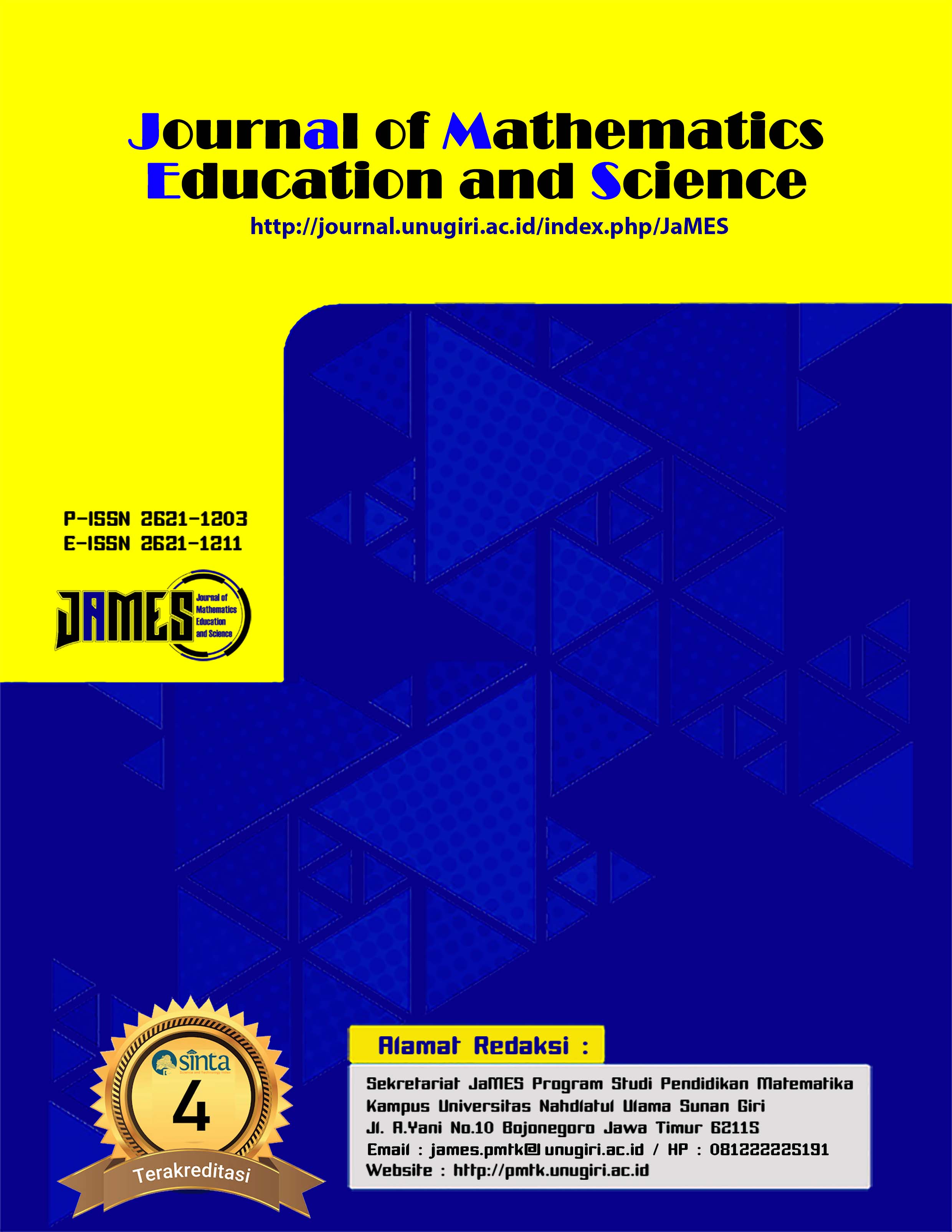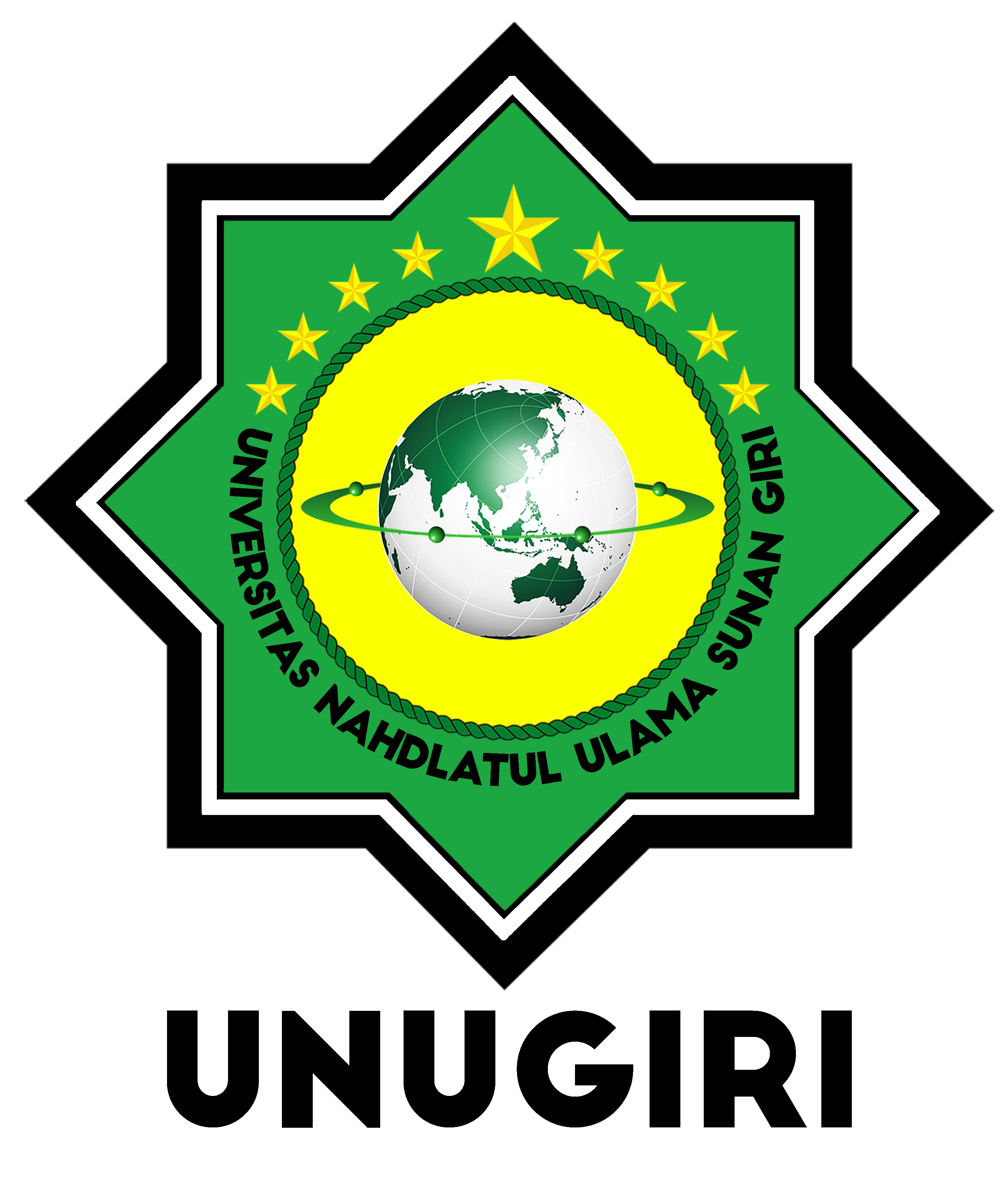Implementasi Think Pair Share: Dampak Terhadap Kemampuan Analisis Matematis, Berpikir Reflektif dan Kreatif
 PDF Download: 177
PDF Download: 177
DOI:
https://doi.org/10.32665/james.v7i2.2712Keywords:
Cooperative Think Pair Share Type, Mathematical Analysis Ability, Reflective and Creative Thinking, Kooperatif Tipe Think Pair Share, Kemampuan Analisis Matematis, Berpikir Reflektif dan KreatifAbstract
Kompetensi dasar yang dapat dicapai oleh siswa, seperti analisis matematis, berpikir reflektif, dan kreatif, memainkan peran penting dalam mendukung proses pembelajaran. Penelitian ini bertujuan untuk mengeksplorasi bagaimana kemampuan dalam analisis matematis, berpikir reflektif, dan kreativitas memengaruhi siswa yang terlibat dalam pembelajaran kooperatif, khususnya dengan mengimplementasikan model bertipe think pair share bersama metode ekspositori. Studi ini melibatkan 63 siswa yang terbagi menjadi dua kelas, yaitu kelas eksperimen dengan 32 siswa yang menerapkan model pembelajaran kooperatif tipe think pair share dan kelas kontrol dengan 31 siswa yang menerapkan metode ekspositori. Teknik pengambilan sampel dilakukan dengan menerapkan metode cluster random sampling, dengan tes sebagai metode pengumpulan data utama. Analisis data melibatkan berbagai uji diantaranya validitas, tingkat kesulitan, daya pembeda, reliabilitas, serta uji untuk normalitas dan homogenitas. Melalui penerapan uji MANOVA untuk pengujian hipotesis, peneliti menyimpulkan bahwa terdapat dampak dari keterampilan menganalisis matematis, berpikir reflektif dan kreatif pada siswa yang terlibat dalam pembelajaran kooperatif menggunakan model pembelajaran tipe think pair share bersama dengan metode ekspositori. Siswa yang menggunakan model pembelajaran kooperatif tipe think pair share akan memiliki efisiensi berpikir lebih tinggi dan memiliki akses terhadap metode pembelajaran terkini
References
T. D. Hastjarjo, “Rancangan Eksperimen-Kuasi,” Bul. Psikol., vol. 27, no. 2, p. 187, 2019, doi: 10.22146/buletinpsikologi.38619.
N. Kusumawardani, J. Siswanto, and V. Purnamasari, “Pengaruh Model Pembelajaran Kooperatif Tipe STAD Berbantuan Media Poster Terhadap Hasil Belajar Peserta Didik,” J. Ilm. Sekol. Dasar, vol. 2, no. 2, p. 170, 2018, doi: 10.23887/jisd.v2i2.15487.
I. Warsah, “Islamic religious teachers’ efforts to motivate students and implement effective online learning,” Edukasi Islam. J. Pendidik. Islam, vol. 10, no. (01), p. 383, 2021.
M. Mariamah, M. Muslim, G. Gunawan, A. Hidayat, and Suratman, “The Effectiveness of Think Pair Share (TPS) Integrated Problem-Solving Learning of Students’ Mathematic Ability,” J. Phys. Conf. Ser., vol. 1933, no. 1, pp. 0–8, 2021, doi: 10.1088/1742-6596/1933/1/012073.
A. Sulisto and N. Haryanti, Model Pembelajaran Kooperatif (Cooperative Learning Model). Purbalingga: CV. Eureka Media Aksara, 2016. doi: 10.46244/visipena.v2i1.36.
S. P. Sari and S. S. Madio, “Pengaruh Penerapan Model Pembelajaran Kooperatipe Tipe Think Pair Share (TPS) Terhadap Hasil Belajar Matematika Siswa SMP,” Mosharafa J. Pendidik. Mat., vol. 2, no. 1, pp. 37–54, 2013, doi: 10.31980/mosharafa.v2i1.269.
A. Shiomin, Model Pembelajaran dalam Kurikulum. Yogyakarta: Ar-ruz Media, 2014.
S. Rohim and K. Umam, “The E Ffect Of P Roblem -P Osing And T Hink -P Air -S Hare L Earning M Odels On S Tudents ’ M Athematical P Roblem -S Olving S Kills And,” Vol. 4, No. 2, Pp. 287–291, 2019.
N. Izzati, “Meningkatkan Kemampuan Analisis Matematis Mahasiswa Pada Mata Kuliah Kajian Pembelajaran Matematika Modern Melalui Pembelajaran Kolaboratif Murder,” J. Pendidik. Mat., vol. 3, no. 1, p. 15, 2017, doi: 10.18592/jpm.v3i1.1179.
A. Anwar and S. Sofyan, “Teoritik tentang Berpikir Reflektif Siswa dalam Pengajuan Masalah Matematis,” Numer. J., vol. 5, no. 1, 2018.
L. Zahra, B. S. Anggoro, T. T. Wijaya, and S. Widyawati, “The influence of probing-prompting learning model toward students’ mathematical reflective thinking skills,” J. Adv. Sci. Math. Educ., vol. 1, no. 2, pp. 65–71, 2021, doi: 10.58524/jasme.v1i2.58.
Dian, C. Kartika, Kriswandani, and N. Ratu, “Analisis Kemampuan Berpikir Reflektif dalam Menyelesaikan Soal Cerita Materi Persegi Bagi Siswa Kelas VIII SMP Kristen 02 Salatiga Tahun Ajaran 2017/2018,” J. Kajian, Penelit. dan Pengemb. Kependidikan, vol. 9, no. 1, pp. 1–4, 2018.
Ramadhani, N. Fitri, and I. N. Aini, “Kemampuan berpikir reflektif matematis siswa dalam menyelesaikan masalah yang berkaitan dengan bangun ruang sisi datar,” Pros. Sesiomadika, vol. 2, no. 1c, 2020.
M. Muntazhimah, T. Turmudi, and S. Prabawanto, “The relation between prior knowledge and students’ mathematics reflective thinking ability,” J. Phys. Conf. Ser., vol. 1731, no. 1, pp. 0–6, 2021, doi: 10.1088/1742-6596/1731/1/012043.
I. F. Jayanto and S. H. Noer, “Kemampuan Berpikir Kreatif Dengan Pembelajaran Guided Discovery,” Semin. Nas. Mat. dan Pendidik. Mat. 2017, pp. 245–254, 2017.
M. Ahmad, Rohani, A. U. Siregar, and Sabri, Pendidikan Matematika Realistik untuk Membelajarkan Kreativitas dan Komunikasi Matematika, 1st ed. Jawa Tengah: NEM-Anggota IKAPI, 2022.
B. S. Anggoro, S. Agustina, R. Komala, K. Komarudin, K. Jermsittiparsert, and W. Widyastuti, “An Analysis of Students’ Learning Style, Mathematical Disposition, and Mathematical Anxiety toward Metacognitive Reconstruction in Mathematics Learning Process Abstract,” Al-Jabar J. Pendidik. Mat., vol. 10, no. 2, pp. 187–200, 2019, doi: 10.24042/ajpm.v10i2.3541.
H. Herdiana, E. E. Rohaeti, and U. Sumarmo, Hard skills dan soft skills matematika siswa. Bandung: PT. Reflika Aditama, 2017.
R. D. F. D. Kusuma, S. P. Nasution, and B. S. Anggoro, “Multimedia Pembelajaran Matematika Interaktif Berbasis Komputer,” Desimal J. Mat., vol. 1, no. 2, p. 191, 2018, doi: 10.24042/djm.v1i2.2557.
R. Widyastuti, Suherman, B. S. Anggoro, H. S. Negara, M. D. Yuliani, and T. N. Utami, “Understanding Mathematical Concept: The Effect of Savi Learning Model with Probing-Prompting Techniques Viewed from Self-Concept,” J. Phys. Conf. Ser., vol. 1467, no. 1, 2020, doi: 10.1088/1742-6596/1467/1/012060.
Y. Febrianti, Y. Djahir, and S. Fatimah, “Analisis kemampuan berpikir kreatif peserta didik dengan memanfaatkan lingkungan pada mata pelajaran ekonomi di SMA Negeri 6 Palembang,” J. PROFIT, vol. 3, no. 1, pp. 121–127, 2018.
B. S. Anggoro et al., “Mathematical-Analytical Thinking skills: The Impacts and Interactions of Open-ended Learning Method & Self-Awareness (Its Application on Bilingual Test Instruments),” Al-Jabar J. Pendidik. Mat., vol. 12, no. 1, pp. 89–107, 2021, doi: 10.24042/ajpm.v12i1.8516.
S. A. Octavia, Model-model Pembelajaran. Yogyakarta: Deepublish, 2020.
N. L. Suryani, “Pengaruh lingkungan kerja non fisik dan komunikasi terhadap kinerja karyawan pada PT. Bangkit Maju Bersama di Jakarta,” JENIUS (Jurnal Ilm. Manaj. Sumber Daya Manusia), vol. 2, no. 3, p. 419, 2019.
A. Astawa and Tegeh, “Pengaruh Model Pembelajaran Kooperatif Tipe Make A Match Berbantuan Media Powerpoint Terhadap Hasil Belajar IPA,” Publ. Pendidik., vol. 10, no. 3, p. 223, 2020, doi: 10.26858/publikan.v10i3.15159.
A. P. Kanah and N. Herdiani, “Pemilihan teknik sampling berdasarkan perhitungan efisiensi relatif,” J. Stat. Univ. Muhammadiyah Semarang, vol. 6, no. 2, 2018.
A. Fauzy, Metode Sampling. Universitas Terbuka, 2019.
I. Masturoh and N. Anggita, “Pengaruh Kedisiplinan Guru Dan Motivasi Belajar Siswa Terhadap Peningkatan Prestasi Belajar Siswa Di MI Se-Kecamatan Wonodadi Kabupaten Blitar,” vol. 1, pp. 52–65, 2018.
K. E. Lestari and M. R. Yudhanegara, Penelitian Pendidikan Matematika. Refika Aditama, 2015.
E. N. Hakimah, “Pengaruh Kesadaran Merek, Persepsi Kualitas, Asosiasi Merek, Loyalitas Merek Terhadap Keputusan Pembelian Makanan Khas Daerah Kediri Tahu Merek ‘POO’ Pada Pengunjung Toko Pusat Oleh-Oleh Kota Kediri,” J. Nusant. Apl. Manaj. Bisnis, vol. 1, no. 1, pp. 13–21, 2016.
H. Susanto, A. Rinaldi, and Novalia, “Analisis Validitas Reabilitas Tingkat Kesukaran Dan Daya Pembeda Pada Butir Soal Ujian Akhir Semester Ganjil Mata Pelajaran Matematika,” J. Japan Soc. Respir. Endosc., vol. 37, no. 3, p. 343, 2015.
M. Khumaedi, “Reliabilitas Instrumen Penelitian Pendidikan,” J. Pendidik. Tek. Mesin Univ. Negeri Semarang, vol. 12, no. 1, 2012.
Netriwati, N. R. Aini, and M. S. Lena, Metode Peneliatian. CV IRDH, 2019.
I. P. A. A. Payadnya and I. G. A. ngurah T. Jayantika, Panduan Penelitian Eksperimen Beserta Analisis Statistik Dengan SPSS. Yogyakarta: Deepublish, 2018.
Sutrisno and D. Wulandari, “Multivariate Analysis of Variance (MANOVA) Untuk Memperkaya Hasil Penelitian Pendidikan,” , AKSIOMA J. Mat. Dan Pendidik. Mat., vol. 9, no. 1, p. 37, 2018.
U. Usmadi, “Pengujian Persyaratan Analisis (Uji Homogenitas Dan Uji Normalitas),” Inov. Pendidik., vol. 7, no. 1, pp. 50–62, 2020, doi: 10.31869/ip.v7i1.2281.
A. Quraisy, “Normalitas Data Menggunakan Uji Kolmogorov-Smirnov Dan Saphiro-Wilk,” J-HEST J. Heal. Educ. Econ. Sci. Technol., vol. 3, no. 1, pp. 7–11, 2022.
Downloads
Published
Issue
Section
Categories
License
Copyright (c) 2024 Journal of Mathematics Education and Science

This work is licensed under a Creative Commons Attribution-NonCommercial-ShareAlike 4.0 International License.
Authors who publish with this journal agree to the following terms:
- Authors retain copyright and grant the journal right of first publication with the work simultaneously licensed under a Creative Commons Attribution License that allows others to share the work with an acknowledgment of the work's authorship and initial publication in this journal.
- Authors are able to enter into separate, additional contractual arrangements for the non-exclusive distribution of the journal's published version of the work (e.g., post it to an institutional repository or publish it in a book), with an acknowledgment of its initial publication in this journal.
- Authors are permitted and encouraged to post their work online (e.g., in institutional repositories or on their website) before and during the submission process, as it can lead to productive exchanges, as well as earlier and greater citation of published work
 PDF Download: 177
PDF Download: 177















